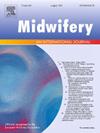大流行期间孕妇对COVID-19疫苗的犹豫:一种混合方法
IF 2.5
3区 医学
Q1 NURSING
引用次数: 0
摘要
对疫苗的直接担忧、个人因素、社会文化和环境因素等多种原因导致孕妇对COVID-19疫苗犹豫不决。目的:该研究描述并比较了大流行期间孕妇对COVID-19疫苗接种的看法,并确定障碍和促进因素。采用混合方法的研究设计,将定量和定性的描述方法相结合。在土耳其西部地区的一家国立医院,对2022年3月至8月期间在产科诊所就诊的249名孕妇进行了问卷调查,并对其中17名孕妇进行了深入的个人访谈。访谈主题基于参与者对COVID-19疫苗的看法和态度。采用混合方法的研究设计,通过定量目的抽样描述和比较他们的COVID-19疫苗接种情况,定性目的抽样确定他们对COVID-19疫苗的犹豫,通过内容分析进行分析。报告遵循GRAMMS指南。66%的孕妇没有接种COVID-19疫苗。年龄较大、受教育程度较低和收入较低的人群表现出较高的疫苗犹豫水平。孕妇对COVID-19疫苗的犹豫主要表现为三个主题:与疫苗直接相关的犹豫、个人因素的犹豫和社会文化和环境因素的犹豫。结论新冠肺炎大流行期间出现的疫苗犹豫是值得关注的重要问题。这种犹豫可以用三个主要主题来解释:疫苗本身引起的疫苗犹豫,个人因素引起的疫苗犹豫,以及社会文化和环境因素引起的疫苗犹豫。此外,与疫苗接种计划管理有关的看法、个人和婴儿相关的风险效益评估、反疫苗活动人士在社交媒体上的影响以及政治因素等子主题也被认为在疫苗犹豫中发挥了重要作用。本文章由计算机程序翻译,如有差异,请以英文原文为准。
Examining the hesitations of pregnant women towards COVID-19 vaccines during the pandemic: A mixed methods approach
Background
Various reasons stemming from direct vaccine concerns, individual factors, and sociocultural and environmental factors contribute to vaccine hesitancy among pregnant women regarding COVID-19 vaccines.
Aims
The study described and compare pregnant women’s perspectives on COVID-19 vaccination during the pandemic and to identify barriers and facilitators.
Findings
A mixed-methods research design was adopted to integrate quantitative and qualitative descriptive methods. At a state hospital in the western region of Turkey, 249 pregnant women attending the maternity clinic from March to August 2022 were surveyed using questionnaires, and in-depth individual interviews were conducted with 17 of them. The interview topics were based on the participants’ perceptions and attitudes toward COVID-19 vaccines. A mixed-methods research design was adopted, using quantitative purposive sampling to describe and compare their COVID-19 vaccination status and qualitative purposive sampling to identify their hesitations regarding COVID-19 vaccines, analyzed through content analysis. Reporting followed the GRAMMS guidelines.
Discussion
Sixty-six percent of pregnant women had not received the COVID-19 vaccine. Those with advanced age, lower education levels, and lower income exhibited higher levels of vaccine hesitancy. The hesitations of pregnant women toward COVID-19 vaccines revealed three main themes: direct vaccine-related hesitation, hesitation arising from individual factors, and hesitation stemming from socio-cultural and environmental factors.
Conclusion
Vaccine hesitancy, which emerged during the COVID-19 pandemic, was a significant cause for concern. This hesitancy was explained by three main themes: vaccine hesitancy arising from the vaccine itself, vaccine hesitancy due to individual factors, and vaccine hesitancy stemming from socio-cultural and environmental factors. Additionally, sub-themes such as perceptions related to the management of the vaccination program, personal and infant-related risk-benefit assessments, the influence of anti-vaccine activists on social media, and political factors were also identified as playing a significant role in vaccine hesitancy.
求助全文
通过发布文献求助,成功后即可免费获取论文全文。
去求助
来源期刊

Midwifery
医学-护理
CiteScore
4.50
自引率
7.40%
发文量
221
审稿时长
13.4 weeks
期刊介绍:
Midwifery publishes the latest peer reviewed international research to inform the safety, quality, outcomes and experiences of pregnancy, birth and maternity care for childbearing women, their babies and families. The journal’s publications support midwives and maternity care providers to explore and develop their knowledge, skills and attitudes informed by best available evidence.
Midwifery provides an international, interdisciplinary forum for the publication, dissemination and discussion of advances in evidence, controversies and current research, and promotes continuing education through publication of systematic and other scholarly reviews and updates. Midwifery articles cover the cultural, clinical, psycho-social, sociological, epidemiological, education, managerial, workforce, organizational and technological areas of practice in preconception, maternal and infant care.
The journal welcomes the highest quality scholarly research that employs rigorous methodology. Midwifery is a leading international journal in midwifery and maternal health with a current impact factor of 1.861 (© Thomson Reuters Journal Citation Reports 2016) and employs a double-blind peer review process.
 求助内容:
求助内容: 应助结果提醒方式:
应助结果提醒方式:


